Five yoga poses to help with anxiety
Surrender Your Stress
Anxiety can be overwhelming. If you often feel like the stress of daily life is just too much, you are not alone. With the complexity and pace of our modern existence, millions of people struggle with stress and anxiety every day, which can leave you feeling hopeless and powerless. It’s extremely helpful to have some trusted techniques to help calm and centre yourself when you feel like your life is out of control.
By taking a few minutes out of your day, you can help soothe your mind and relieve anxiety with these basic, yet potent, yoga poses. Even if you just pick one pose and enjoy that for 15-20 minutes, it will have a profound effect on your life. A simple, regular yoga practice can support your nervous system to be able to better cope with stress and up your resilience, while also helping you release worry and rediscover inner peace.
Why is Yoga so helpful?
Yoga involves mindfulness, deep breathing and focusing the mind. This is radically helpful when dealing with anxiety. Just the simple practice of conscious breathing makes a massive difference to an anxious physiology, instantly calming the physical responses of the body. Yoga trains the mind and body to be calm so that when you experience a particularly stressful situation, you have the skills to bring yourself back, soothe yourself and return to your centre, even in the chaos of high emotion. A yoga practice is supportive of clarity and wisdom. Often we receive the answers to questions we’ve been agonising over or realise that what we’re anxious about will pass. Yoga brings in fresh energy, unblocks the energy system and calms the mind. It is an amazing workout for body, mind and spirit.
These easy yoga poses are appropriate for everyone to practice, and will help to alleviate anxiety. Make sure to wear comfortable clothing and find a quiet, area to take some time out for yourself. Spend at least 15 to 20 minutes in each posture.
Child’s Pose
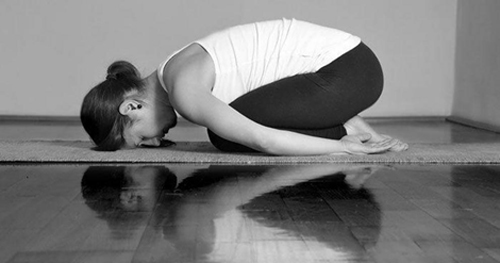
Child’s pose is a deeply restful and relaxing pose, often taken as a rest pose during more demanding yoga sequences. Kneel on your mat, sitting back on your heels either keeping the knees together, or separating them about as wide as your hips. Exhale and fold forward, bringing your head to the floor, or supporting it with a blanket or cushion and laying your hands alongside your torso with the palms up. Release through the shoulders, relax the body, and focus on the breath. If you have difficulty sitting on your heels in this pose, place a thickly folded blanket between your back thighs and calves. You can also use a bolster or thick cushion, which will be hugged in the child’s pose, making it particularly nurturing.
Cat/Cow Pose
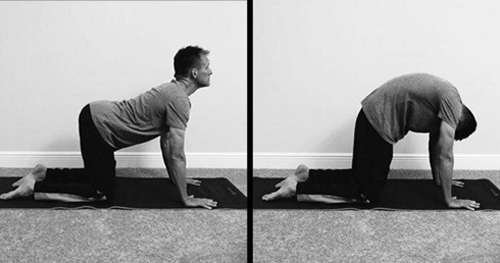
The bulk of our nerves run along the spine. When we calm our nervous system, the entire body relaxes. The power of yoga is that it stimulates the parasympathetic nervous system (rest and digest) and calms the fight flight response of the sympathetic nervous system. The cat/cow pose nourishes the nervous system and instantly relaxes the body, releasing tension trapped in the spinal cord. It is a relaxing and enjoyable pose with wonderful benefits.
To practice the pose, come onto all fours with your hands below the shoulders, fingers spread, and knees below the hips. Synchronising breath and movement, inhale as you lower the belly and draw the shoulders together, opening the chest whilst looking up (cow pose), then arch the back up towards the ceiling as you exhale, drawing down the head to look at the navel, as you move into the cat pose. Repeat these movements several times making them fluid and slow; mindfully moving through each vertebrae with your breath, as if you’re in a moving meditation. Close your eyes to bring your attention inward. This is a deeply relaxing and enjoyable sequence.
Legs Up the Wall
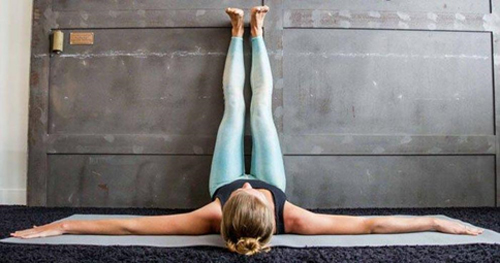
The ultimate restorative pose, this posture has an unbelievable amount of benefits and will literally put you back together again! If you pick just one pose to practice, let it be this one. Place your mat up against a clear wall with space for you to stretch your legs. Sit on your bottom with the right side of your body pushed against the wall. Swivel up your legs onto the wall as you bring the back onto the floor, keeping the bottom close to the wall. With the legs straight, relax with your palms, facing them upwards at your sides, and use an eye pillow if that’s comfortable for you, to soothe your mind. Focus on your breath, you can do an equal breathing ratio where you count to five as you slowly breathe in and then count to five again as you exhale. Alternatively, you could do a basic breathing practice of doubling the exhalation; so counting to four as you breathe in then lengthening the exhale to eight counts as you breathe out. Surrender into deep rest while your body enjoys the healing benefits of this pose. It is an antidote to exhaustion, illness and weakened immunity, relieves headaches, mild depression, anxiety and insomnia. This pose is a deeply restorative pose for the heart, mind and lymphatic system.
Forward Bends
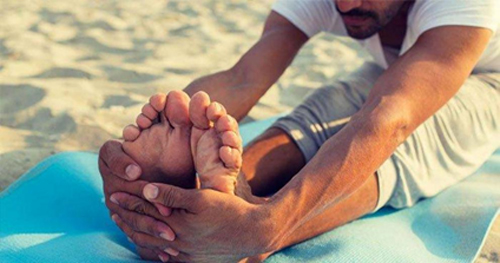
In yoga, forward bends are soothing, calming and supportive of deep rest and sleep. The inward nature of forward bends also encourages introspectiveness and stillness. Most people find forward bends quite challenging, due to tight hips and hamstrings, so it is important to do a restorative, supported forward bend so that you don’t strain yourself in the pose. Choose either a standing forward bend or a seated forward fold. It doesn’t matter how far you bend, it’s about releasing through the spine and the inverted nature of the pose, where your head is below your heart. Always ensure you are not straining any part of your body. You want a nice opening and stretch without pain or strain.
Standing Forward Bends
With your feet a hips width apart, fold forward from the hips, keeping your alignment. Lengthen the front of the body as you fold, keeping the neck and jaw relaxed. Keep the knees soft until you’re more flexible and can straighten the legs. Use props if you need to, such as a bolster to rest your arms on. Release through the neck and the head as you remain in the pose for a few minutes. Uncurling, come up slowly, being particularly careful if you suffer from dizziness or low blood pressure.
Seated Forward Bends
Sit on the mat with your legs stretched out in front of you. Extend your arms up above your head and then fold forward over your legs, making sure there is no pain or discomfort. You can either round the back or keep it flat. Use a bolster to support your head and bend your knees if you find this pose challenging. Hold here for a few minutes and then slowly roll back up to sitting again.
Shavasana (Rest Pose)
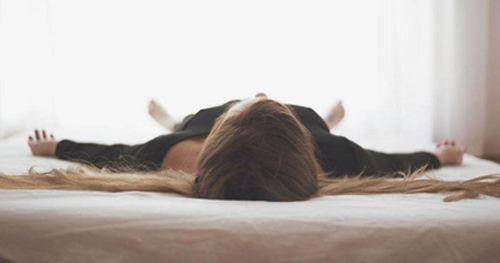
Lay on your mat on your back, arms at your sides, palms facing upwards, legs slightly apart, feet turning outwards. Ensure that your body is properly aligned and that you feel comfortable. If you have lower back issues, you can use a bolster or folded pillow under your knees. Consciously relax each part of your body, moving up from the feet, legs, hips and so on, just letting go. You can also release tension by first tightening each part of the body, squeezing all your muscles momentarily, and then releasing. Focus on your breath allowing the mind to settle as you come to deep rest. Let your thoughts pass gently as you drop into stillness.
Shavasana is a lovely pose to practice Yoga Nidra or put on a guided meditation, if you find it difficult to stop your mind racing. Said to be the easiest physical pose but the most difficult yoga pose to master, Shavasana, or corpse pose, is where you discover the opportunity to die to life; to surrender completely and to practise letting go. This is hugely beneficial for anxiety, as so often we worry about things that are out of our control. The more we can learn to let go and find acceptance, the easier it is to find equanimity and inner peace. Surrender and enjoy the feeling of deep relaxation, having nothing to do and nowhere to go; just taking time for self care and rest.
These simple yoga poses can be a nourishing gift to yourself. Practising them regularly can grow into a habit which will bear the fruit of a calm mind and body. Establishing such beneficial habits that fuel our inner peace and increase our capacity to deal with life can make all the difference. We all feel anxious at times, but having the tools to regain control when you’re feeling overwhelmed means that anxiety doesn’t call the shots – you do!
yogaesoteric
June 20, 2019
